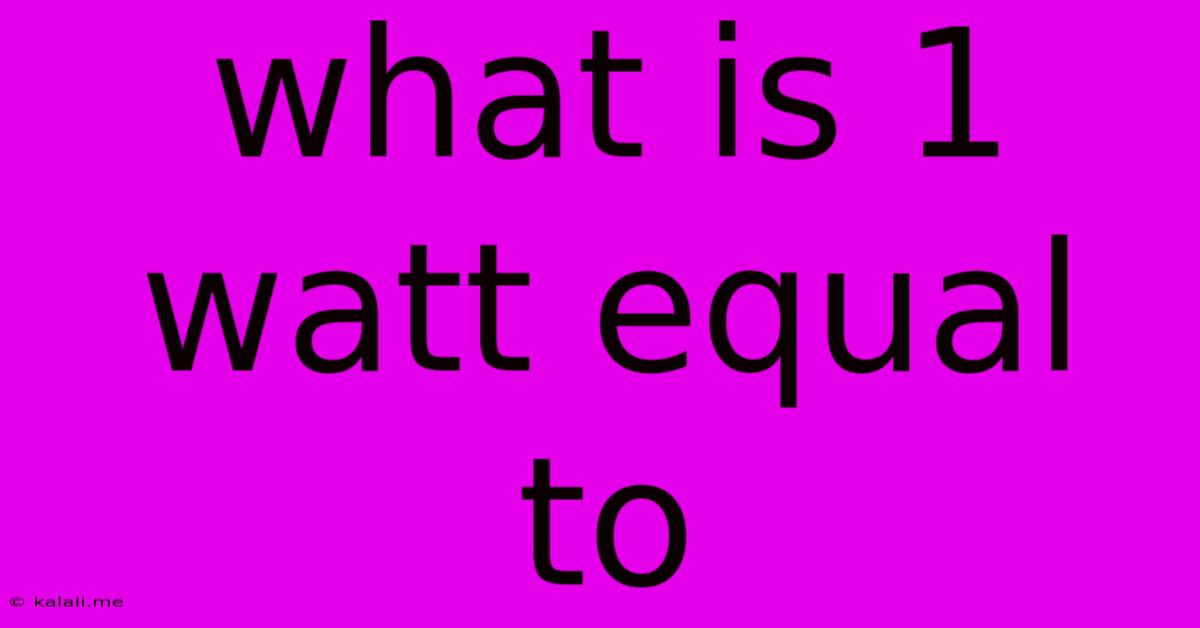What Is 1 Watt Equal To
Kalali
Jun 14, 2025 · 3 min read

Table of Contents
What is 1 Watt Equal To? Understanding Power in Simple Terms
What is a watt? This seemingly simple question opens a door to understanding a fundamental concept in physics and engineering: power. This article will break down what a watt represents, its relation to other units, and provide practical examples to solidify your understanding. We'll explore the relationship between watts, volts, amps, and joules, helping you grasp this crucial concept.
Defining the Watt: The Unit of Power
A watt (W) is the fundamental unit of power in the International System of Units (SI). Power, in simple terms, is the rate at which energy is transferred or converted. Think of it like this: a powerful engine can transfer a lot of energy (do a lot of work) quickly, while a less powerful engine transfers energy more slowly. The watt quantifies this rate.
One watt is equal to one joule per second (1 J/s). This means that a device consuming one watt of power uses one joule of energy every second. To put it another way, if a light bulb uses 60 watts, it's consuming 60 joules of energy every second.
Watts, Volts, and Amps: The Power Triangle
Watts aren't isolated; they're intricately linked to volts and amps. This relationship is crucial for understanding electrical power.
- Volts (V): Represents electrical potential difference, or the "push" of electricity. Think of it as the pressure in a water pipe.
- Amps (A): Represents electrical current, or the flow of electricity. Think of it as the amount of water flowing through the pipe.
- Watts (W): Represents power, the rate at which electrical energy is used. This is analogous to the amount of work done by the water flow.
The relationship between these three is expressed by the following formula:
Power (Watts) = Voltage (Volts) x Current (Amps)
or W = V x A
For example, a device operating at 120 volts and drawing 0.5 amps has a power consumption of 60 watts (120 V x 0.5 A = 60 W).
Practical Examples of Watt Usage
Understanding watts helps us compare the energy consumption of different devices. Here are some examples:
- Light Bulbs: Traditional incandescent bulbs range from 40W to 100W, while energy-efficient LEDs can operate at significantly lower wattages (e.g., 5W to 15W) while providing similar brightness.
- Household Appliances: Appliances like refrigerators, microwaves, and air conditioners consume varying amounts of power, often measured in hundreds of watts. The wattage is usually indicated on a label on the device.
- Electronics: Laptops, smartphones, and other electronic devices also use watts to describe their power consumption, often ranging from a few watts to tens of watts.
Beyond the Basics: Kilowatts and Other Units
For larger power consumption, we use kilowatts (kW), which is equal to 1000 watts. This unit is commonly used to measure the power of larger appliances and power generation. You'll often see kilowatts used on electricity bills, indicating your energy usage over a specific period. Other units, like megawatts (MW) and gigawatts (GW), are used for even larger scales, such as power plants.
Understanding the watt is fundamental to comprehending how energy is used and consumed in our everyday lives. This knowledge allows for better energy management, informed purchasing decisions, and a deeper appreciation for the physics behind our technology.
Latest Posts
Latest Posts
-
Time Taken By Sunlight To Reach Earth
Jun 15, 2025
-
What Are The Miller Indices For The Plane Shown Below
Jun 15, 2025
-
What Is The Shortcut Key That Repeats The Last Task
Jun 15, 2025
-
690 Is 23 Of What Number
Jun 15, 2025
-
Find The Prime Factorization Of 75
Jun 15, 2025
Related Post
Thank you for visiting our website which covers about What Is 1 Watt Equal To . We hope the information provided has been useful to you. Feel free to contact us if you have any questions or need further assistance. See you next time and don't miss to bookmark.